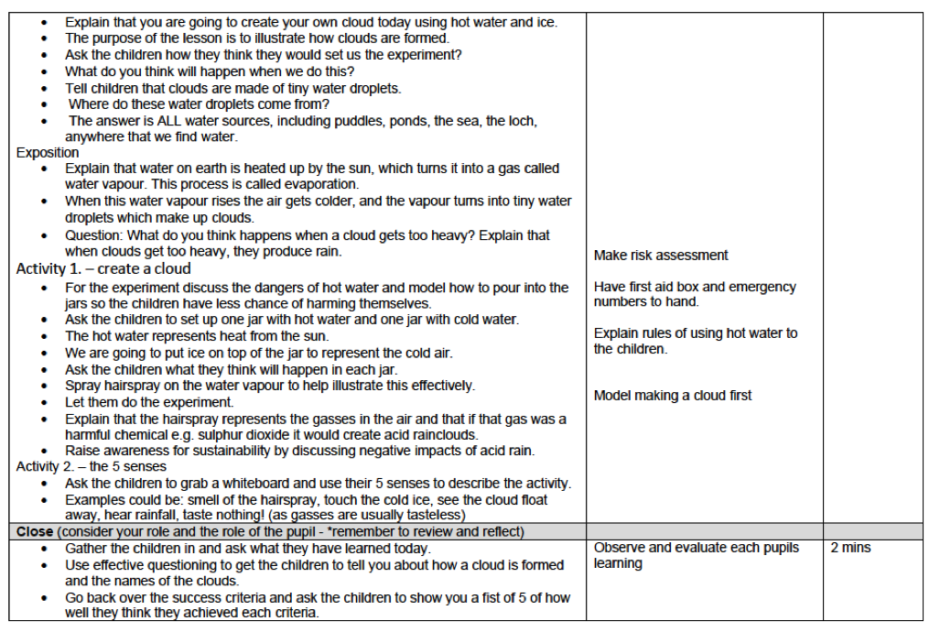Lesson Planning and Rationale by Becky, Jessica, Sophie (Yr 3 University of Stirling 2020)
Eyes on the Sky! A sequence of three lessons


Geocaching (Lesson 2 of three) is extracted here




Rationale for the lesson (Extract)
In designing our sequence of three lessons, for our level one pupils, we attempted to incorporate place, science and sustainability as common threads running throughout every lesson. The National Trust (2020) highlight a lack of engagement with nature in the present climate and it was our hope that within our lessons relationships with our local setting could be constructed. We also hoped to create within our learners a wider sense of self in a global environment. The need to enhance human connections with the environment is at the heart of sustainability and thus within the Scottish Curriculum for Excellence (Ross and Mannion 2012). The purpose of this rationale is to highlight how we hope to achieve place responsive, science conscious and sustainability aware learning intentions within a somewhat restrictive curriculum. The aim is to go further than the blanket outcomes of educational standards and create more collaborative, lasting achievements (Gruenewald 2003). We hope to motivate and engage learners encouraging an ability to question and analyse the world around us (Learning and Teaching Scotland 2010). I will argue that it is important to include outdoor learning within the curriculum to access the affective domain and build learner and teacher confidence (Van der Hoeven Kraft et al. 2011). Due to the limited access to nature that children currently experience it is vital that we highlight the benefits and encourage others to step outside the classroom and teach the benefits of the multisensory, learning rich environment we have within our reach (Mannion et al. 2012). It was vital for our lessons to be place responsive hence our decision to locate, for lesson two, on an open section of land, a hill, where the sky was clearly visible when standing or lying down. Place based learning centres around the curriculum but uses the environment to create a context to learn (Van der Hoeven Kraft et al. 2011). We are able to adapt the lesson dependent on weather: from cloud watching, to considering where the rain falling comes from, to asking how mist forms. Our questioning will relate at all times to the water cycle and air pollution in whichever manner the opportunity presents itself that day. This is curriculum’ due to a place-based response (Ross and Mannion 2012). Mannion et al. (2012) state that teachers are not the only influence on building the curriculum when it comes to place responsive pedagogies, in fact they describe the natural environment as a “coauthor”. The university as a location is an interesting option due to its inner city yet natural feel, it juxtaposes the human built environment with wildlife. Cars and construction are visible from our waypoint while also being within a vast expanse of managed grassland and close to tree cover. According to Ingold (2000) this relates to a dwelling versus a building perspective, how the learners see the environment depends on which perspective their culture has encouraged. Lesson three once again involves an element of cloud watching and an expressive arts activity that consolidates the children’s learning, this considers visible pollution from their own school’s outdoor space. This is changeable depending on the school’s placement near industry or transport. At its core the intention of using place within this context is to enhance the relationship between our learners and the environment (Mannion et al. 2012). Our purpose is to connect to the children’s own experiences and create a concrete link between human behaviour and the environment in their minds (Gruenewald 2003). Learning and Teaching Scotland (2010) describe “rich urban and rural environments” within reach of all Scottish schools. The value of teaching outdoors is clear in how meaningful the learners find the experience and structuring these connections can achieve significant and memorable experiences (Mannion et al. 2011). Science as a concept must be taught in these experiential ways in order to motivate enduring interest (Education Scotland 2020b).
